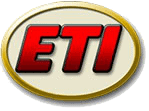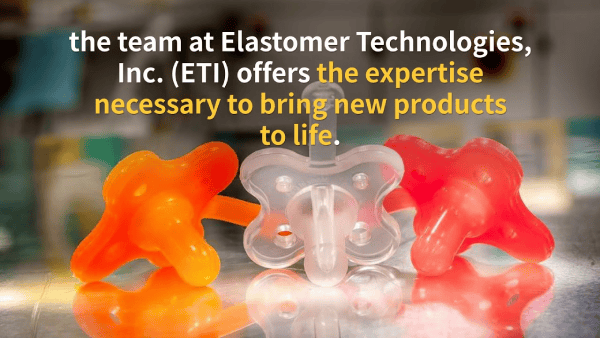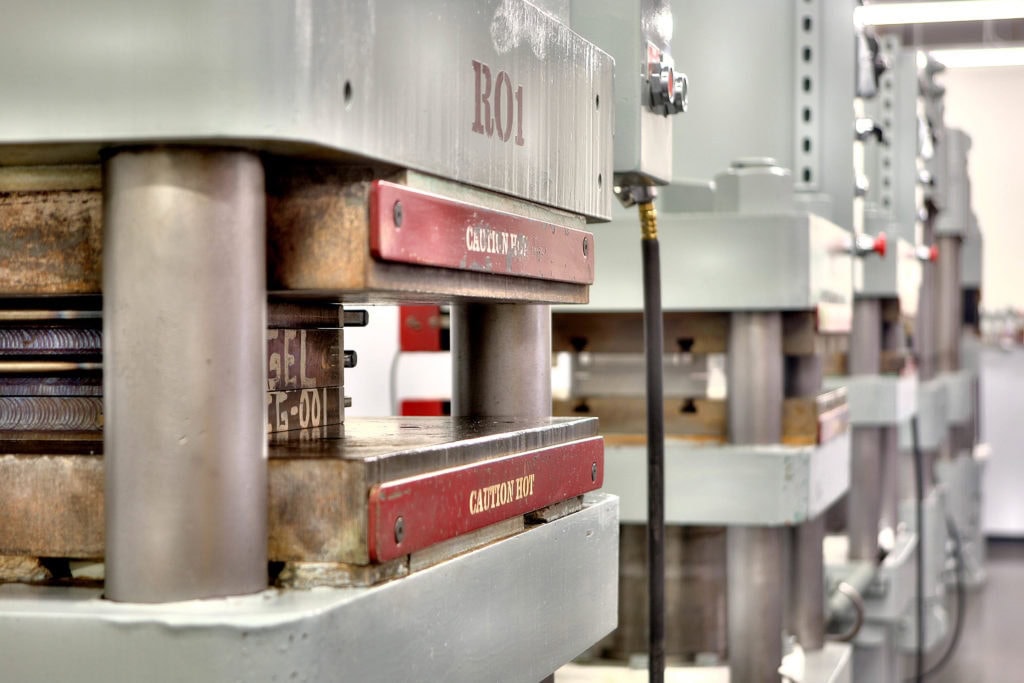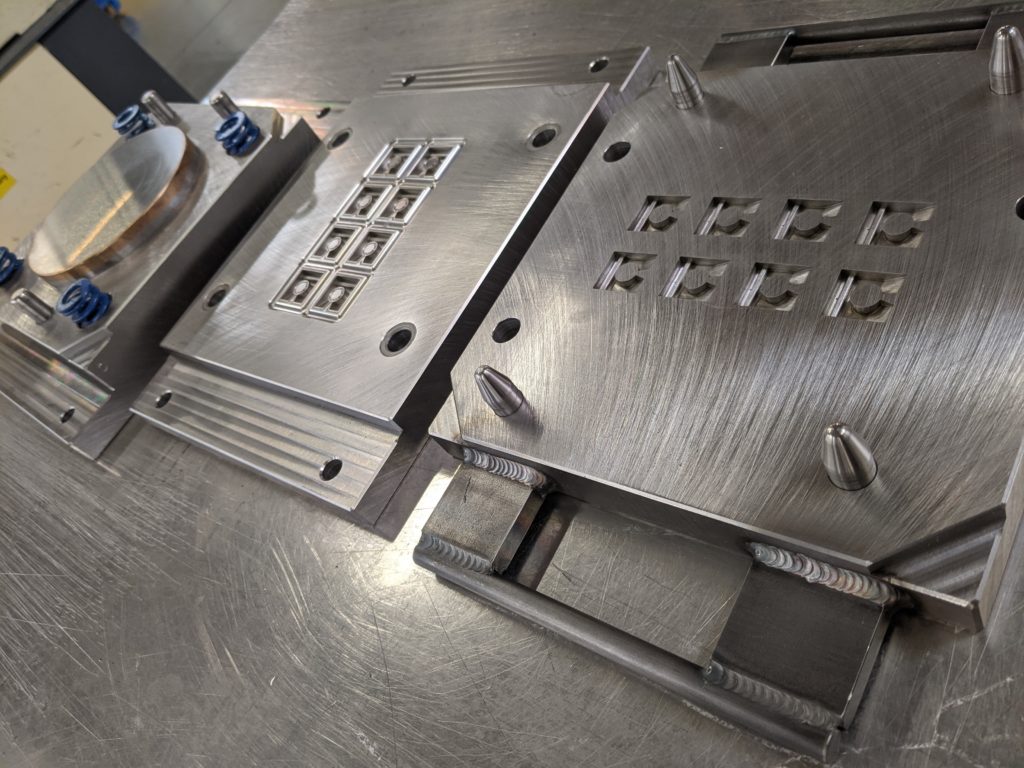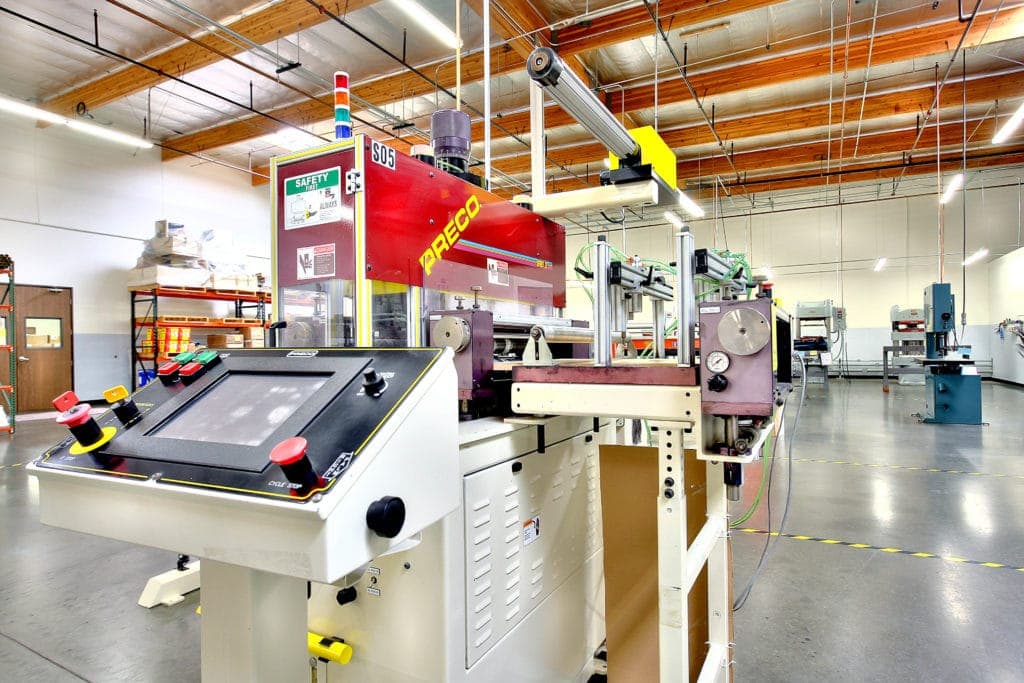Services & Capabilities
The right molding or die cutting method for a product depends on many factors. A manufacturer must not only consider the component’s size, shape, and function but also the end application’s environment, desired production volume, and ideal budget. To ensure the right fit for your project, it’s important to work with an experienced partner whose molding & die cutting expertise spans multiple manufacturing techniques.
At Elastomer Technologies, Inc., we’ve spent over 30 years translating our client’s needs into accurate, effective, and affordable solutions. We craft premium-quality products at every volume via our compression molding, transfer molding, rubber molding, liquid injection molding, and other processes. Whether you’re seeking prototypes or a high-volume production run, we’ll work with you to find the processes and materials that suit your needs.
Services & Capabilities
At ETI, we know that there is no one-size-fits-all technique for processing parts. Our services include a variety of molding processes, each ideal for different manufacturing challenges.
Compression Molding
Compression molding involves pressing a heated rubber compound into a mold to create the desired shape. The process yields high-quality components with excellent repeatability, all at a cost-effective price. It is also a highly versatile technique, easily accommodating complex part geometries and non-standard materials.
In addition to standard compression molding, we are also equipped to meet specialized requirements. For instance, we offer dual-material molding to create parts from two materials including colors. We can also process parts in a Class 100,000 clean room to prevent contamination.
Transfer Molding
Transfer molding is similar to compression molding in that it uses heat and pressure to transfer uncured elastomers into molds. However, in transfer molding, the material must be pushed through a sprue and gate rather than being loaded directly into the part of the mold that has the parts geometry. This can provide greater control over dimensional tolerances and minimizes flashing.
Transfer molding has a reasonable upfront cost and can achieve rapid cycle times. For many projects, it offers the ideal balance of product quality, cost, and speed. Also, while transfer molding is cheaper to set up, injection mold services are often more efficient, so it often becomes the cheaper option at high production volumes. ETI’s team will help you balance these considerations and choose the right approach for your project.
Liquid Injection Molding
Liquid injection molding is one of the most efficient elastomer molding techniques available as it can be fully automated to minimize cycle times. In this process, a pump dispenses liquefied silicone rubber into a sealed mold to create a closed loop cycle. The molds often contain multiple cavities to create many components in a single cycle.
Apart from its high efficiency, injection molding also offers excellent accuracy and repeatability, even for complex geometries. Our injection molding presses feature precision-built tooling that tightly controls shot size, ensuring consistency across long production runs. Our 50- and 100-ton presses are also fully equipped for lights-out manufacturing, maximizing efficiency and throughput. These capabilities give us the flexibility to tackle jobs of any production volume.
Prototype Molding
Prototype molding services draw from other molding processes to create real, working prototypes at an affordable price. Accurate prototyping provides critical information about component performance and manufacturing logistics, making production cycles faster and more predictable.
ETI’s prototype molding services include:
- Pour Molding of RTV Silicone. Pour molding room-temperature-vulcanizing silicone is a quick and cost-effective method of producing rough working prototypes.
- Transfer or Compression Molding of HCR or Liquid Silicone. Transfer and compression molding are both excellent choices when a prototype needs to mimic the final product more closely. These molding techniques create high-quality parts in the material of choice, including high-consistency rubber silicone or other liquid silicone materials. When the design is finalized, clients can continue with transfer or compression molding, or they can invest in longer-lasting injection mold tooling.
- Injection molding can be used to produce highly accurate prototypes. Injection molding can be used to produce highly accurate prototypes. However, due to the up-front tooling costs, this is used toward the end of the design process for components that will be produced in high volumes.
Whether you’re seeking initial proof-of-concept or in-depth performance testing, ETI can help you develop a prototyping plan that fits seamlessly into your timeline and budget.
Die Cutting
Die cutting refers to a set of manufacturing services that use a die and press to cut or form shapes from flat sheets of material. It can be used with materials of all kinds, including plastic, rubber, foam, fabric, composites, paper, and metal. In addition to being versatile, die cutting is also extremely fast, and it offers a cost-effective means of producing large quantities of components.
At ETI, we use three different varieties of die cutting to accommodate diverse client needs:
- Traditional Die Cutting. Traditional die cutting is suitable for most projects, offering an affordable and customizable means of shaping parts.
- High-Speed Die Cutting. Our high-speed die-cutting services leverage automation to achieve rapid cycle times and decrease price per part. We offer high-speed die cutting to clients requiring large production volumes or rapid turnarounds.
- High-Speed Converting. We offer high-speed converting for clients seeking precision parts with tight control over dimensional tolerance. This process is also suitable for high-volume, high-speed production.
All of our die-cutting services rely on a comprehensive line of automatic Preco systems, clicker presses, punch presses, and traveling head presses. This versatile range of equipment allows us to fulfill orders with varied specifications, materials, sizes, and volumes.
Summary of Services at ETI
| Pros | Cons | Materials | Applications | Production Volume | |
| Compression Molding | Offers colored parts
Can be used to create unique shapes or parts with complex insert requirements
Can be used for dual material molding
Tooling costs are significantly less for co-molded assemblies |
Excess flash
Creates more waste than other methods Not always suitable for some complex parts
Slower process times |
Silicone
Fluorosilicone Conductive rubber material FKM and other fluorocarbon rubbers. Neoprene EPDM Butyl SBR Polyisoprene Nitrile rubber Custom rubber compounds. Filled materials |
Aerospace
Defense Dental Energy Film Mechanical Medical Packaging Public Infrastructure Recreation
|
Low volume
High volume
50 to 1,000,000 parts
Prototype |
| Prototype Molding | Creates real parts for measuring performance while allowing for optimal cost efficiency
Reduces potential for reworking and shortens overall production cycles
ETI provides 3 different types |
Not all prototypes can lead directly to production (depends on the employed process)
Prototyping can largely vary based on project |
RTV Silicone | Dentistry
Medicine Energy Film Packaging Aerospace Defense Recreation Consumer products
|
Lower volumes (can be made higher at a higher cost) |
| Transfer Molding | Offers colored parts
Can offer reliable and cost effective way to reduce cycle times and overall project costs
Ability to make rubber parts with metal inserts
Design flexibility accommodates complex features
Faster setup time & lower tooling cost |
Transfer pads and sprues cannot be reused
Can be more costly for parts in comparison to other processes because its process is labor intensive
Less control over process than injection molding. |
Silicone
Fluorosilicone Conductive rubber material FKM and other fluorocarbon rubbers. Neoprene EPDM Butyl SBR Polyisoprene Nitrile rubber Custom rubber compounds. Filled materials.
|
Dentistry
Medicine Energy Film Packaging Aerospace Defense Recreation Consumer products
|
Low volume
High volume
Prototype |
| Liquid injection Molding | Shorter cure times
Easily repeatable which is beneficial for creating high quality complex parts Closed loop process minimizes material contamination Can be automated. |
Excess Flash
Expensive tooling and minimum material purchases Environmental and chemical limitations associated with the use of silicone |
Liquid silicone rubber
HCR silicone |
Aerospace and aviation
Automotive Electronics Food and beverage Medical and dental |
Minimum of 1000 to 20,000. No maximum. |
| Die Cutting (Traditional Die Cutting, High Speed Die Cutting, High Speed Converting) | Suitable for high volume production runs
Highly customizable |
When used to process thicker materials the parts may have issues with bowing of cut surfaces. | Rubber
Foam Plastics Vulcanized fiber Cardboard Low impact materials Fabrics Adhesives Plastic films Light grade metals |
Various industrial applications:
gaskets, washers, labels, optical films, insulating foams, medical components, vehicle parts, packaging, and more |
100 to 50,000 units
Prototype High volume |
Summary of Services at ETI
Compression Molding
Pros
Offers colored parts
Can be used to create unique shapes or parts with complex insert requirements
Can be used for dual material molding
Tooling costs are significantly less for co-molded assemblies
Cons
Excess flash
Creates more waste than other methods
Not always suitable for some complex parts
Slower process times
Materials
Silicone
Fluorosilicone
Conductive rubber material
FKM and other fluorocarbon rubbers.
Neoprene
EPDM
Butyl
SBR
Polyisoprene
Nitrile rubber
Custom rubber compounds.
Filled materials
Applications
Aerospace
Defense
Dental
Energy
Film
Mechanical
Medical
Packaging
Public Infrastructure
Recreation
Production Volume
Low volume
High volume
50 to 1,000,000 parts
Prototype
Prototype Molding
Pros
Creates real parts for measuring performance while allowing for optimal cost efficiency
Reduces potential for reworking and shortens overall production cycles
ETI provides 3 different types
Cons
Not all prototypes can lead directly to production (depends on the employed process)
Prototyping can largely vary based on project
Materials
RTV Silicone
Applications
Dentistry
Medicine
Energy
Film
Packaging
Aerospace
Defense
Recreation
Consumer products
Production Volume
Lower volumes (can be made higher at a higher cost)
Transfer Molding
Pros
Offers colored parts
Can offer reliable and cost effective way to reduce cycle times and overall project costs
Ability to make rubber parts with metal inserts
Design flexibility accommodates complex features
Faster setup time & lower tooling cost
Cons
Transfer pads and sprues cannot be reused
Can be more costly for parts in comparison to other processes because its process is labor intensive
Less control over process than injection molding.
Materials
Silicone
Fluorosilicone
Conductive rubber material
FKM and other fluorocarbon rubbers.
Neoprene
EPDM
Butyl
SBR
Polyisoprene
Nitrile rubber
Custom rubber compounds.
Filled materials.
Applications
Dentistry
Medicine
Energy
Film
Packaging
Aerospace
Defense
Recreation
Consumer products
Production Volume
Low volume
High volume
Prototype
Liquid injection Molding
Pros
Shorter cure times
Easily repeatable which is beneficial for creating high quality complex parts
Closed loop process minimizes material contamination
Can be automated.
Cons
Excess Flash
Expensive tooling and minimum material purchases
Environmental and chemical limitations associated with the use of silicone
Materials
Liquid silicone rubber
HCR silicone
Applications
Aerospace and aviation
Automotive
Electronics
Food and beverage
Medical and dental
Production Volume
Minimum of 1000 to 20,000. No maximum.
Die Cutting (Traditional Die Cutting, High Speed Die Cutting, High Speed Converting)
Pros
Suitable for high volume production runs
Highly customizable
Cons
When used to process thicker materials the parts may have issues with bowing of cut surfaces.
Materials
Rubber
Foam
Plastics
Vulcanized fiber
Cardboard
Low impact materials
Fabrics
Adhesives
Plastic films
Light grade metals
Applications
Various industrial applications:
Gaskets
Washers
Labels
Optical Films
Insulating Foams
Medical Components
Vehicle Parts
Packaging and more
Production Volume
100 to 50,000 units
Prototype
High volume
Capabilities
At ETI, we are proud to apply our innovative processes and extensive expertise to a wide range of projects.
Industries & Applications
As an ISO 13485:2016 and 9001:2015-certified elastomer manufacturer, we happily serve clients from across industries, including those with the most rigorous specifications. In our three decades of elastomer experience, we have solved unique challenges for clients from the medical, consumer goods, food and beverage, and specialty products industries. Please review our portfolio for examples of successful projects within and beyond these industries. Whatever your application’s challenges, we have the skills and equipment necessary to provide the performance components you need.
Expert Guidance
At ETI, we pride ourselves on centering the client at every stage in the process. We use a proprietary Project Forecast battery for design analysis, which helps our engineers zero in on the most important factors influencing a project’s success. This tool considers product function, environment and application, physical requirements, and material demands alongside practical considerations like budget and timeline. From there, we can develop a fully custom manufacturing plan tailored to the customer’s unique expectations.
One of the most complicated decisions in any elastomer project is the choice of material. As part of our expert design guidance, we draw on decades of practical experience to help clients find the optimal elastomer for their needs. We similarly match each material and production timeline with the most effective molding technique to minimize lead times and maximize ROI.
Automation & Efficiency
At ETI, we draw on the latest technology to ensure quick turnaround. Our facility is fully equipped for lights-out molding, allowing us to manufacture around the clock while keeping labor costs down. These processes are supported by energy-efficient, 100%-electric equipment that further reduces production costs. We pass the savings from our streamlined production line onto consumers, whether they’re seeking low-volume prototypes or high-volume production runs.
Get a Molding/Die Cutting Project Started with ETI
ETI delivers top-quality products that successfully align with our clients’ expectations. We treat every project as a partnership, forming long-lasting relationships with our clients so that we can truly understand their needs.
To learn more about our molding & die cutting services and capabilities, reach out to us or request a quote today.
